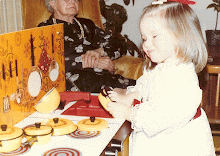In Part Three of our "Learn to Cook" series, we are going to take a step beyond the pasta toss and try to do a little more actual cooking. But we'll still keep it simple by sticking to just one pot. Cooking is much less intimidating if you only have one pot on the stove to monitor. No need to worry that your sauce will burn while you were concentrating on sauteing the meat or tending to the veggies roasting in the oven. For beginners (or for experienced cooks who happen to have distractions, like, say, a three year old who is using your legs as a tunnel for his cars), knowing that you just have one pot on the stove, happily bubbling away, can be comforting and confidence-building.
For this month's recipe, I've chosen to give you my 30-minute version of jambalaya. I've made "real" jambalaya before, and it was completely and utterly wonderful. But it also required a lot of time on the stove. Then, about a decade ago, I discovered a recipe for 20-minute jambalaya in Desperation Dinners, by Beverly Mills and Alicia Ross. It still had all the great, Louisiana flavors -- spicy sausage flavoring those good old staples, rice and beans -- but was on the table in 20 mins. Over the years, I have altered the recipe a bit (mainly using Emeril Lagasse's jambalaya recipe from Potluck), in favor of starting with a "Cajun mirepoix" and fresh thyme.* It is still ready in about 30 minutes and the hardest part is chopping the veggies -- and how hard is that?
One note for the beginners out there: Don't be intimidated by the long-ish list of ingredients. You mostly just dump them into a pot and let them sit. And don't be intimidated the list of spices/herbs, either. All of these (bay leaves and oregano, especially) are worth having in your pantry, as they provide the flavor backbone of many, many meals. And if you don't want to buy something, just leave it out. The only things I wouldn't dream of leaving out are the rice, beans, sausage, and thyme.
JAMBALAYA
Source: adapted from Desperation Dinners, Beverly Mills & Alicia Ross; Potluck, Emeril LagasseServes: 6
Time: 30 mins.
- 1 tsp butter
- 1 large onion
- 1 large bell pepper
- 2-3 stalks celery
- 2-3 cloves garlic
- 8 oz.-1 lb. kielbasa or andouille sausage
- 1 3/4 c rice
- 1 can chicken broth
- 1/4 c white wine (or more water)
- 3 bay leaves
- 4 sprigs fresh thyme
- 1/2 tsp onion powder
- 1/2 tsp. dried oregano
- 1/2 tsp. black pepper
- 1 can white beans
- 1 can black beans
- 1 can stewed tomatoes
- Optional ingredients: hot sauce to taste, green onions for garnish, cubed ham, cooked shrimp, chicken
- Chop the onion, green pepper, and celery. You should have about 1 c. of each, but there is no need to measure -- just eyeball it. Melt the butter in a large pot or skillet that has a lid. Add the veggies and cook until they begin to soften -- about 2 mins. Add the garlic and cook for another 2 mins., stirring often.
- Cut the sausage into 1/4-inch thick slices and add to the pot, cooking for another 2 mins. or so.
- Add the rice and stir to blend, cooking for another minute or two. Add the chicken broth and wine, stirring to moisten all the rice. Add the thyme and bay leaves. Cover the pan and cook until the rice is getting tender (5-15 mins., depending on what type of rice you used).
- Meanwhile, combine the onion powder, oregano, and black pepper in a little cup. Rinse and drain the beans.
- Add the spice mixture, beans, and tomatoes to the pot. Cover again and let cook until the rice has absorbed most of the liquid and the flavors have blended -- about 10 mins. Taste and adjust seasonings. Serve.
- Note on optional ingredients: Jambalaya comes in as many forms as there are cooks in Louisiana kitchens. So if you simply have to have chicken, or ham, or shrimp in your jambalaya -- add it! If you are starting with raw chicken, I'd add it (cut into bite-sized pieces) to the pot first, brown it in some oil or butter, then remove it from the skillet and proceed with the recipe. (Add it back in with the beans.) If you are adding ham, I'd add that with the sausage. Cooked shrimp? With the beans. And in our house, we don't add any hot sauce to the pot, because this is one of our kids' favorite meals, but they can't take the spice. But Matt and I pass the bottle of hot sauce back and forth at the table, like a ping-pong match.
Enjoy!
M
Other one-pot recipes on this blog: Super Bowl Chili and Quickie Shepard's Pie (only uses one pot if you have an oven-proof skillet and don't have to transfer to a casserole dish).
*In case inquiring minds want to know: What is a mirepoix? A mirepoix is a combination of three "aromatics" -- vegetables -- sauteed to create a base of flavor on which to build a dish. In fact, the repeated use of a specific mirepoix in a given culture is what lends a consistent, common, underlying taste to all of the traditional dishes of that culture. Traditionally, in French cuisine, a mirepoix is made up of onions, celery, and carrots -- usually sauteed in butter. In Cajun/Creole cuisine, green peppers take the place of the carrots in the trinity of vegetables.




No comments:
Post a Comment